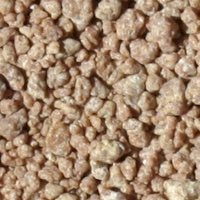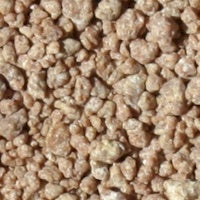Megalac
Megalac
- DM:97.0%
- Protein: 0.0%
- ME MJ/kg:33.25%
- Fibre: 0.0%
- Oil: 84.0%
- Ash: 12.5%
Couldn't load pickup availability
Megalac is a concentrated source of digestible undegradable energy. It does not interfere with rumen function, as the calcium protects the fatty acids against breakdown in the rumen and they pass in to the abomasum. Here the acidic conditions dissolve the calcium and release the fatty acids so they can be digested with maximum efficiency.
Megalac is produced by a saponification reaction in which fatty acids from the palm oil industry are reacted with calcium (Ca). This produces rumen-insoluble, rumen-inert Ca salts of fatty acids which have no negative effects on rumen fibre digestion or rumen function, unlike ‘free’, unprotected oils.
No other feed ingredient provides more energy for milk production than Megalac.
How Megalac works
Megalac works according to acid / alkali differences. At rumen pH (ideally >6.0) the Ca salts are stable, but when they enter the acidic conditions of the small intestine the product breaks down into its constituent fat and Ca components – both of these components are then available to the animal for absorption.
The balance of saturated and unsaturated fatty acids in Megalac, the content and delivery of C18:1 fatty acids to the small intestine, and the fact that the fat is present as free fatty acids rather than triglycerides helps ensure the product has a high digestibility; digestibility has been determined at 96% in dairy cows.
Megalac delivers unsaturated fatty acids to the small intestine and can increase digestibility of the total fat and other components in the diet. The ME of Megalac is 33.3 MJ/kg DM; this is approximately 2.5 times the energy concentration of typical cereals.
Megalac is the only fat product with a measured NEL value. This value was determined in calorimetric chambers with milk producing cows in the USA. The NEL of Megalac is 27.3 MJ/kg DM, proving that the energy in Megalac is used very efficiently for milk production.
Megalac has been widely proven in independent research studies over the past 25 years to increase milk production. A recent study at the University of Reading (UK) reported an improvement in milk yield of 4.3 kg/day when cows were offered Megalac at 500 g/cow/day for the first 120 days in lactation, an increase of over 500 kgs per cow (Figure 1). The average milk yield response to supplementation is 2.3 kg/cow/day.
[week_of_lactation] IMG
Figure 1 Effect of Megalac on milk production (Aikman et al., 2008)
Megalac can be added to rations to help reduce heat stress in dairy cows and other ruminant animals. As it is not fermented in the rumen and the energy is used very efficiently for milk production, Megalac can help reduce metabolic heat production and has a lower heat increment than other ingredients.
As a rumen-protected fat, Megalac does not add to the acid load in the rumen. Unlike rapidly fermented cereal starches, Megalac is a very ‘safe’ method of increasing energy density and can help reduce the incidence and extent of acidosis.
Megalac is well-proven to improve cow fertility (Table 1). Feeding Megalac increases dietary energy density to help reduce negative energy balance in the early lactation period when dry matter intake is limited. A 500 g/d supplement of Megalac typically increases energy density by 0.5 MJ/kg DM. Reducing negative energy balance is a key factor in helping reduce body condition score loss which is closely related to fertility.
Megalac has positive effects on follicle growth and improves quality and viability of ovulated eggs, increasing the chance of a successful pregnancy. Supplementing with Megalac is an effective method of increasing progesterone concentration in blood plasma; adequate progesterone, ‘the hormone of pregnancy’, is essential to ensure successful pregnancy.
Recent research has demonstrated the importance of fatty acid profile of fat supplements in improving cow fertility. Megalac protected fat delivers unsaturated fatty acids to the small intestine which can help improve cow fertility.
|
Control
|
Megalac-supplemented
|
|
| Conception rate to 1st service (%) |
33.7
|
45.5
|
| Conception rate to 2nd service (%) |
28.8
|
75.0
|
| Pregnancy rate (%) |
52.3
|
86.4
|
Table 1 Effect of feeding Megalac on cow fertility (Garcia-Bojalil et al., 1998)
As almost half the fatty acids in Megalac are unsaturated and in rumen-protected form, inclusion of Megalac in rations can effectively reduce the proportion of saturated fatty acids in milk fat and increase the proportion of unsaturated fatty acids, particularly C18:1.

Typical Analysis
| Dry Matter | 95 |
| Crude Protein | 0 |
| DCP | 0 |
| ME | 33.25 |
| Crude Fibre | 0 |
| Oil | 84 |
| Ash | 12.5 |
| NCGD | 87.6 |
| NDF | 0 |
| Starch | 0 |
| Sugar | 0 |
| Starch & Sugars | 0 |
| FME | 0 |
| Salt | 0 |
| Calcium | 9.3 |
| Total Phos | 0 |
| Av Phos | 0 |
| Magnesium | 0 |
| Potassium | 0 |
| Sodium | 0 |
Recommended feeding
(per head / day)
Limits to Usage
Feed to adult ruminants
Storage / Processing
Disclaimer
Feeding rates are estimates, and other factors, such as animal health and environment, can have a greater impact on how animals perform. There is no guarantee that animals will perform as expected if fed the suggested rates. Rations should be balanced to provide enough energy and protein for animals, and they should include enough forage to keep the rumen healthy. Animals also need access to fresh water at all times.
- Choosing a selection results in a full page refresh.
- Opens in a new window.
